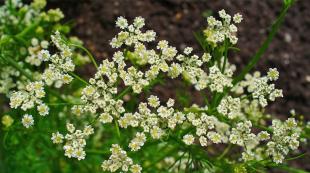Cut gladioli to last longer. How to prolong the flowering of gladiolus. How to name a bouquet of gladiolus: examples


You can start cutting gladiolus flowers when the first lower flower fully blooms on the peduncle. Gladioli stand in the water for a very long time and alternately open every single new bud, from bottom to top. It is necessary to cut flowers so that the corm does not have time to use up all the reserves accumulated for a successful wintering for flowering. Each grower approaches the issue of cutting flower stalks in his own way. Some recommend breaking out the peduncle so as not to transfer various infectious diseases of gladiolus from plant to plant during cutting. It is good to follow this rule, but in practice it can be very difficult to break off a flower without disturbing the root system, since along with the twisting of the gladiolus arrow, the bush easily turns out of the ground. Therefore, it is better to pierce the peduncle with a clean, pointed knife, and then carefully break it off.
When cutting flower arrows, we always try to get as tall flowers as possible - these are the ones that seem to us the most decorative and suitable for a gift bouquet. But we must also remember that when cutting the gladiolus peduncle, it is imperative to leave as many leaves on the plant as possible, since the more leaves remain on the gladiolus, the larger and more enduring the corm grows. But since the leaves of gladioli are often high on the flower stem, flower growers cut the flower along with the leaves. The right way out in this situation lies in a simple solution: it is enough to feel with your hand in the leaf fan the place where the convex peduncle passes and with the help of a sharp flat blade of the knife with the other hand pierce the peduncle itself through the fan of leaves. Then gently, holding the puncture site with one hand, try to break and pull the peduncle out of the rosette of leaves with the other hand.
Gladiolus inflorescences are cut in the morning, leaving at least 4-5 lower leaves on the plant. Flowers are placed in a vase, regularly changing the water and updating the bottom cut. Withered buds are removed as they bloom on the peduncle. To keep the gladioli in a vase for longer than 2 weeks, add half an aspirin tablet or a few crystals of citric acid and half a teaspoon of sugar per 1 liter of water to the water. To decorate bouquets, instead of leaves, ordinary calamus leaves are added to high flower arrows, which are very similar to noble gladiolus leaves and go well with flowers.
The dream of any housewife - stretch ceilings! What beauty I saw on the site
Every hostess is pleased to see a beautiful bouquet of tall and lush flowers on the table in the living room, which can remain fresh for a long time. In order for the appearance of flowers to please the residents of the house and their guests, you need to know how to keep cut gladioli in a vase using the simplest and most affordable methods that do not require expensive preparations. First of all, experts tell those who wish how to properly cut a gladiolus, because an unsuccessful cut can not only shorten the life of cut flowers, but also damage the bulbs and make them unsuitable for subsequent planting. Gardeners believe that the stem of the gladiolus should be cut in the place where the cut will be closed by the remaining leaves. They will cover the damaged stem and prevent water from rain or watering from entering. as a result, a correct and healthy corm will form, which will give beautiful flowers next year.
Of great importance for the preservation of flowers in a vase is the weather in which the stems are cut and the time of day. Flower growers warn that it is best to cut in the morning, before 11 o'clock and in the evening after 18 o'clock. If it is a cloudy rainy day, gladioli are cut at any time, because they have accumulated enough moisture to make the flowers feel comfortable. It is known that the flowers on the stem begin to bloom from the bottom, so cutting is carried out when there are 2 or 3 fully bloomed flowers. However, quite often gladioli are cut in the state of buds, in which case they will take shape gradually and there will be several fresh flowers on the stems within 10 or 15 days. When corrugated dense gladioli grow in a flower bed, you need to wait until 4 or 5 lower flowers bloom, only after that they can be cut and placed in a vase.
EXPERT OPINION
Before placing the gladiolus in a vase, you need to check the cuts of the stems, they should be fresh, smooth and made a little oblique. They especially carefully examine the flowers bought in the store, or donated by someone they know. If necessary, the tips are cut a little and after such processing they are placed in a suitable dish. It should be borne in mind that the stems should not rest against the bottom of the vase, otherwise they begin to bend and the bouquet will lose its beautiful appearance. Sometimes they use a special device that allows flowers to be suspended, you can make it yourself or purchase it at a flower shop. Knowing how to store cut gladioli, the hostess will have a beautiful fresh bouquet on the table for 10 days or even 2 weeks.
To better preserve the bouquet of their gladioli, it is desirable to create a suitable environment for them, for which various substances are lowered into the water. The most well-known remedy is aspirin, the tablet of which should be crushed and the powder poured into water prepared for flowers. An equally effective way is to add granulated sugar, in one liter of water you need to dissolve a couple of teaspoons of sugar and pour the solution into a flower vase. Similarly, they use activated charcoal (1 tablet), ammonia (3 drops), salt (1 teaspoon, or vinegar, which you need one tablespoon. Each housewife has her own recipe in order to keep a beautiful bouquet for a long time.
If gladioli are cut correctly and in a timely manner, they will remain fresh and attractive for at least 10 days, but the water must be changed every day or at least every other day. It is best to use chilled boiling water, but if you can pour spring water into the vase, the flowers will undoubtedly last even longer. Withered flowers must be cut off, and the tips of the stems should be trimmed a little each time the water is changed. Such care is quite enough to keep gladioli in a vase fresh and beautiful for quite a long time.
You were presented with a very beautiful bouquet of flowers on March 8, birthday, New Year or just like that, and you want it to please you with its beauty, charm, as well as pleasant memories for as long as possible, and you have a question: How to extend the life of a cut flowers.
Before placing the flowers in a vase, remove any leaves from the bottom of the stems that will be under water. Roses also have their thorns removed.
Flowers with a solid stem are split to a depth of 3-4 cm and pieces of matches are put into the split so that the edges do not converge.
Spraying with water is useful for almost all flowers - this replaces dew for plants.
Flowers that secrete milky juice are cut under water, and then placed in warm water. The ends of the stems of flowering branches must be kneaded until they turn into fibers and placed in a weak solution of potassium permanganate. .jpg)
Almost all flowers require daily water changes. At night, a vase of flowers is better to take out in a cool place. With signs of wilting, the bouquet is immersed in water to the very heads of the flowers or covered with a paper cap soaked in water.
Substances dissolved in water prolong the life of flowers: 0.5 teaspoon of sugar per 1 glass of water; 1% glucose solution; 1.5-2% solution of glycerin; 10% alcohol solution; 1 aspirin tablet dissolved in 1 liter of water.
In summer, it is useful to put pieces of charcoal or 1 teaspoon of salt in 1 liter of water into the water.
In order for the flowers to bloom faster, 1 teaspoon of saltpeter or 2 teaspoons of alcohol are added to 4 liters of water, in which 2-3 drops of ammonia must be dissolved, or a piece of quicklime is thrown into the water.
If your bouquet has a long journey ahead, it is best to keep it in water for a while and only then carefully wrap it first in damp paper and then place it in a plastic bag. If you cut the flowers in the morning, and you need to give them in the evening or in a few days, you can wrap the flowers “drunk” with water in wet paper, then in dry paper (or a plastic bag) and put them on the bottom shelf of the refrigerator.
The Rose. Thorns and leaves are removed from the stem almost to the height of the vessel with water, then the ends are flattened with a hammer. You can add 1/2 aspirin to the water.
Carnation. The stem is broken off in the area of the thickened node, dipped briefly in alcohol. Half an aspirin and a couple of pieces of sugar are added to the water. It is not recommended to combine with other colors.
Gladiolus. Cut off when 1-3 lower flowers open. To preserve the cut, use one of the following additives: 0.2 g of salt, 15-20 g of sugar per 1 liter of water, 1 tablet of aspirin or activated charcoal, 1 teaspoon of boric acid, or a few citric crystals. It remains only to recall the general rules.
Water should not be cold (about 18 degrees). It needs to be changed every day. The stems are washed under the tap, the cuts are renewed without removing them from the water by about 2 cm. Vases are best placed in a shaded place where there is no direct sunlight and drafts.
Gladiolus is the recognized king of flower beds. Beautiful and graceful flowers with powerful stems have long occupied a leading place in Russian gardens. In August, you can appreciate all the luxury of flowering gladioli, which have almost all colors in their range: from white to black-red and purple, with different shades and transitions. In order for flowers to please as long as possible, you need to know the features of storing inflorescences and gladiolus bulbs.
How to store cut gladioli?
Gladiolus flowers are cut at different times of the day depending on soil moisture and air temperature. The best time is considered to be the morning hours, since at night the soil is fully stocked with moisture. In moderate temperatures or in cloudy weather, flowers can be cut at any time.
Gladiolus are cut in a half-blown state. Then the flowers placed in a vase with water will gradually open within 10-15 days. When cutting, it is important to keep at least four leaves on the stem. The knife used for cutting is disinfected by treatment in a strong solution of potassium permanganate, alcohol or garlic infusion. Cut flowers are immediately placed in a container of cold water and left in a cool room for 2-3 hours.
Transportation
During transportation, in the first 3-4 days after cutting, the inflorescences are tied in bunches of 10 pieces and sprinkled with water a little (but excluding moisture on the flowers themselves). The top half of the gladioli is then wrapped in tissue paper and placed in cardboard boxes.
During long-term transportation, the stems (3-4 cm) are immersed in liquid paraffin with a temperature of 30-35 0 C. After the paraffin has cooled, the gladioli are wrapped in paper. After unpacking, the stem is cut by 1-2 cm and placed in warm water (20-30 0 C) for 1-2 hours. It is advisable to choose a bright, cool room for these purposes. After paraffin treatment and packaging, the flowers are stored in the refrigerator or on ice (1-3 0 C) for 2-3 weeks.
Solutions for processing
For processing, solutions are used:
- 0.3 g of silver nitrate per 1 liter of water;
- 10 ml of pine extract, 50 g of sugar per 3 liters of water;
- a few drops of ammonia or camphor alcohol;
- a few crystals of potassium permanganate and citric or boric acid per 1 liter of water;
- half a crushed aspirin tablet in 3 liters of water;
- activated charcoal tablet per 1-3 liters of water.
The lifespan of cut gladiolus depends on the quality of the water. The softer the water, the longer the flowers will last. It is ideal to use settled boiled, distilled, filtered water.
Cut flowers must meet certain quality standards. Large-flowered gladioli are divided into three varieties:
- extra - length 80 cm;
- first grade - 60 cm;
- second grade - 40 cm.
Small flowers must meet the requirements for Class I, that is, the length of the plants must be at least 60 cm.
Methods for Commercial Storage of Gladiolus
Corms are stored in a thin layer in boxes, cloth bags or loosely wrapped in paper so that air remains. The optimum temperature in the storage is +3-8 0 C at a relative humidity of 60-70%. Violation of storage conditions leads to drying out of the bulbs, premature germination or disease.
Planting material is inspected 1-2 times a month, the affected bulbs are removed. When mold appears, the corms are dried. If pests appear, the tubers are treated with insecticides.
If the bulbs begin to sprout during storage, they should be dried at room temperature and then placed in the refrigerator. Planting material that has grown roots must be handled with extreme care: broken roots will no longer recover.
How to store gladiolus bulbs?
Some gardeners refuse to grow gladioli for one reason - you need to dig up the bulbs and store them under certain conditions. Corms require a careful attitude: they cannot be piled up, so you have to allocate quite large areas for their storage.
After digging, the tubers need to be prepared for long-term storage. Bulbs left in the ground die already at a temperature of -3-5 0 C. Preparation and storage conditions play a decisive role. When the gladioli fade, the stems of the flower are cut almost to the very base.
Cleaning
Digging time may vary depending on the climatic zone, but October is considered optimal. Experienced gardeners do this in dry sunny weather before the onset of frost. They try to adhere to the rule - the bulbs are dug up no earlier than 30 days after cutting the peduncles.
First, varieties of early flowering period are dug, then early-medium, medium, and so on in terms of flowering. Varieties of dark color (cherry, purple, lavender) are dug out first of all among equal flowering periods due to the fact that they are more susceptible to fungal diseases. The last to remove the bulbs grown from the children.
Digging is carried out with a shovel or pitchfork, carefully removing the earth from the tubers and carefully collecting the separated baby. After digging, the stems and roots are cut off from the bulbs, leaving only a small stump up to 1 cm high. It is not necessary to leave a longer stump: a common gladiolus pest, thrips, likes to gather on the bulbs near the base of the stem.
Preparing for storage
The material is carefully cleaned from the ground, washed, dried and sorted by color and size. Bulbs are best stored in a dry ventilated room with a temperature of 4-9 0 C.
After processing, the bulbs are inspected, separating the mature children. They are not thrown away, because later they will replace the old bulbs. Large, flat rhizomes, which have already been repeatedly used for planting, are considered old planting material. Every year, such bulbs produce smaller and smaller flowers, which are often subject to diseases. They are replaced by children that appear at the base of the bottom of the bulb.
Preparation of gladioli for the storage process takes place in three stages:
- Washing. In addition to washing with running water, gardeners recommend treating planting material with a weak solution of potassium permanganate.
- Drying. The washed material must be dried to prevent its decay. If at least one bulb begins to rot, you can lose all the material. This is due to the fact that wet rot instantly spreads, affecting nearby bulbs.
- Sorting. Professional gardeners divide the bulbs into 6 groups depending on their size. But most often sorting takes place according to the color and size of the material (the darker the bulb, the more intense the color of the flowers). Also, the material is sorted into adult bulbs and children. The following year, the children are planted separately, as they are not yet able to give a full flowering.
Storage
At home, gladioli are stored in low cardboard boxes, in which several holes are made for ventilation. Some gardeners wrap each bulb in thin paper or newspaper. Instead of boxes, you can use wooden boxes, where you also need to make holes. A dry basement or cellar is ideal for storage. Planting material must be constantly monitored, checking the condition of the bulbs 1-2 times a month.
By the middle of winter, the dormant period of the bulbs ends. At this time, they are taken out of the basement and placed in a warm place with diffused sunlight. Then the bulbs begin to sprout. By planting, the length of the sprouts reaches 12-15 cm.
Storage features
Gladiolus will delight for more than one year, if the bulbs are provided with the right storage conditions. Bulbs before long-term winter storage should be prepared:
- collect on time;
- cut correctly;
- rinse and dry;
- process before storage.
Processing the bulbs is not a mandatory procedure, but this will keep the planting material throughout the winter. For processing use a weak solution of potassium permanganate. For 10 liters of water take 10 g of potassium permanganate. Tubers are placed in this solution for 15-20 minutes. Then the bulbs are dried, laid in a box in separate rows.
Drying of the bulbs continues for a month at a temperature of about 20 0 C. Then the planting material is transferred to a place of permanent storage.
Bulbs are wrapped in newspapers or placed in mesh or gauze bags, which are then placed in boxes or boxes. It is better to place in one layer, maximum - in two.
Cold storage
If there is little planting material, then the bulbs can be stored in the refrigerator. To do this, the tubers are placed in the lower compartment of the refrigerator. Here the temperature is about 10 0 C. At the same time, do not forget about the regular check of the condition of the planting material.
Other storage options in the apartment
It can be:
- gaps between frames in wooden windows;
- glazed balcony or loggia;
- unheated pantry;
- place near the front door.
For storage in the apartment, the bulbs are placed in a bag of sand. Keep the bag open to prevent drying out of the planting material. The room where the bulbs are stored must be periodically ventilated. If mold or any stains appear, disinfection is carried out using a manganese solution. After processing, the bulbs are dried and placed back in the bag.
An important point: if, when checking the tubers, hardened or, conversely, tubers that have become too soft, are found, they must be removed.
Before disembarkation
The shelf life of the bulbs is divided into periods of natural and forced dormancy. The first lasts about 40 days. At this time, biological processes take place in the bulb that prevent its germination. Environmental conditions do not matter here. With the beginning of the second period, and provided that the bulb is warm, the first sprouts may appear.
20 days before the planned planting of tubers in the ground, the temperature in the room where gladioli are stored should be about 15 0 C. At this time, cells and growth buds awaken, and the most complex physiological processes begin.
Varieties that have a low rate of safety are treated with paraffin. To do this, the bulbs are dipped in paraffin heated to 30-35 0 C for a few seconds. Then the gladioli are dipped in cold water to harden the paraffin. Such a paraffin layer will become an effective protection against fungi and bacteria, as well as moisture loss. Before planting, the paraffin is removed by hand. You can also use warm water for this.
Diseases and pests during storage
Most often, gardeners are faced with gladiolus diseases caused by bacteria, viruses and harmful fungi. Pests dangerous for bulbs bring a lot of troubles. If we talk about diseases that develop during storage, then they are almost always associated with rotting of the bulbs. The infection enters from the soil during the growing season, often transmitted in a latent form from the mother bulb to the young replacement and children. Various rots are most common in seasons when heavy rainfall and stagnant water in the soil were observed.
Fusarium, septoria, sclerotinia, scab, penicillium rot - these are all diseases that lead to massive rotting of the bulbs both during growth and during storage.
Diseases can be seen in the appearance of the plant and the condition of the bulbs. If the leaves begin to lighten and rot, then the plant is probably affected by furaziosis. The brown color of the leaves and rotting at the base of the stem indicates damage by dry rot. The presence of an infection in only one plant does not mean that the rest of the gladioli were not affected. Most likely, they are also infected. Often, diseases appear in a complex, and several pathogens of various infections can be present on one bulb.
Some pathogens get on the bulb during the growing season, but are invisible when dug up and develop on planting material if stored improperly.
Pests
In addition to diseases, gladiolus can suffer from pests. Thrips, a small sucking insect that feeds on the juice of gladioli, causes the greatest harm. As a result of the activity of thrips, plants weaken, lose their attractive appearance, and also become carriers of various viral diseases. In autumn, at a temperature of about 10 0 C, thrips move to the bulb. If, after digging, the tubers are not treated with insecticidal solutions and stored in a warm room, then the gardener risks losing the entire collection, as ideal conditions will be created for the development of thrips. To combat the pest, gladiolus plantings are sprayed with insecticides at least three times per season. After digging, the bulbs are processed.
For gladioli, the danger is the wireworm. It bites into the tubers, eating out their contents, which can lead to the death of the plant. In addition, fungi can get into wounds caused by insects. To prevent this situation, you do not need to plant gladioli after potatoes and carrots and in areas clogged with wheatgrass.
Protection of gladiolus flowers
At all stages of development of gladioli, a preventive examination is important to detect diseased plants. During the growing season, the diseased flower is dug up and burned to prevent the spread of infection. Bulbs dug in the fall are also carefully examined. Small scab infestations can be disinfected with diamond fluid, for example.
The cause of many diseases is late harvesting of tubers. In autumn, the weather is usually cool and humid - an ideal environment for the spread of many infections. Therefore, do not delay cleaning.
After digging, all plant remains of flowers are removed from the site: they can become a source of disease. The drying step is best done at high temperatures. This will quickly evaporate moisture, preventing it from lingering between the scales, where the infection likes to accumulate.
But even if all the rules of agricultural technology are observed, there is no guarantee that it will be possible to keep the plants healthy. Chemical preparations ("Fundazol", "Maxim" and others) will help fight diseases, with which bulbs need to be treated before storage. Garlic infusion is also suitable for this (300 g of chopped garlic per 10 liters of water). In the process of growth, the plant is treated with copper-containing preparations. Already infected plants are sprayed with pesticides (Aktara, Karbofos).
Pest control
A number of pests can damage gladioli. These are thrips, wireworms, bears, naked slugs, caterpillars.
class="eliadunit">
Gladiolus is a beautiful and elegant flower. It is grown, as a rule, for cutting, because in the flower garden the most beautiful large-flowered varieties have to be tied up to protect them from lodging. Agree, all sorts of supports are not the best decoration. But cut flowers look great, and stand in the water for quite a long time.
For those who want to extend their life in a vase, our today's recommendations are addressed.
The undoubted advantage of the gladiolus is that, when cut, all the flowers of the inflorescence bloom gradually. The downside is the lack of flavor. True, in the 50s of the last century, breeders received the first varieties with a weak aroma (Acacia, Sweet, Fragrans, Yellow Rose, etc.). Breeding work in this direction continues now. However, fragrant varieties have not received wide distribution among flower growers, since they are significantly inferior to unscented ones in terms of decorativeness.
Gladiolus inflorescences are cut at different times of the day, depending on the temperature and the availability of moisture to the plants. With moderate daytime temperatures, sufficiently moist soil and in cloudy weather, gladiolus can be cut at any time of the day. If the summer is hot, then the best time for cutting is early morning.
Cutting can be done when the first bud is half open. In this case, all gladiolus flowers gradually open and inflorescences remain in water for 10-15 days. Many varieties with dense corrugated-folded petals in the phase of a colored bud open the flower rather slowly. Such inflorescences are best cut after the opening of two or three lower flowers.
It is very important when cutting the inflorescence to keep as many leaves on the plant as possible (at least at least four). If you leave only 2-3 leaves, then full-fledged corms and babies will not have time to form. Such corms, if they do not die during winter storage, then the next year they form weak plants.
To cut off as long a peduncle as possible and keep the maximum number of leaves on the plant, I use the following technique. On the flat side of the plant, at the divergence of the fourth and fifth leaves, I make a puncture across the stem with a narrow knife sharpened on both sides. Then, with the movements of the knife to the left and right, I cut the stem as much as possible. You can make the same incision on the opposite side. Holding the plant with my left hand below the puncture (so as not to pull it out of the ground and not damage the roots), with the other hand I break the stem, bend it slightly and, carefully twisting the peduncle, release it from the leaves.
To prevent disease damage, it is necessary to disinfect instruments as often as possible. When cutting a small number of inflorescences - after each plant. For this purpose, it is good to have several knives (they are easy to make from pieces of an old hacksaw blade) to use alternately, after each cut, immersing the blade in a disinfectant solution (alcohol, a strong solution of potassium permanganate, etc.).
Cut flowers should be placed in vessels with cold water as soon as possible (preferably immediately) and left in a cool room for 1-2 hours. After that, for transportation, the inflorescences are bundled, lightly sprinkled with water (drops should not fall on the flowers), packed in thick thin paper, placed in long cardboard boxes, closed with a lid, fastened with adhesive tape. In this form, inflorescences can be transported over long distances (1-2 days). For long-distance transportation, it is necessary, after cutting, to lower the ends of the peduncles (by 3-4 cm) into molten paraffin (30-35 ° C). After the paraffin has hardened, the flowers are wrapped in paper. In this form, they can be stored at a moderate temperature for three to four days. After unpacking, the stem is cut by 1-2 cm and immediately placed in deep vessels with warm water (35 ° C) for 1-2 hours (in a cool, bright room). Gladiolus in buds after treatment of the stems with paraffin and packing in parchment paper can be stored for two to three weeks in the refrigerator (at a temperature of 1-3 ° C). If cut flowers are meant to be sold quickly and have a lot of open flowers, then they are best placed directly in buckets of water. For the stability of the inflorescences, the buckets are covered from above with a large-mesh lattice.
With timely cutting, gladiolus inflorescences stand in a vase for up to two weeks. It is only necessary to remove the fading lower flowers in time, change the water in the vase daily, each time slightly cutting the stems before putting them back in fresh water.
To better preserve fresh gladiolus inflorescences, various compositions of nutrient and preservative mixtures are used. Here are some of them:
class="eliadunit">
0.8 g of potassium alum, 0.3 g of potassium chloride, 0.2 g of table salt, 15-20 g of sugar;
one crushed tablet of aspirin or activated charcoal;
a few crystals of potassium permanganate or citric acid;
a few drops of ammonia or camphor alcohol;
one teaspoon of table salt or boric acid;
10 g of pine extract and 50 g of sugar;
50 g of sugar;
one cap of liquid fertilizer "Effect" per 5 liters of water;
0.3 g of silver nitrate per 1 liter of water.
There are many ready-made chemicals for extending the life of cut gladioli: "Buton-2", "Tsvetin", "Nora", etc. It must also be remembered that the life expectancy of flowers after cutting largely determines the quality of water. The softer the water, the longer the life of cut flowers. It is better to use distilled, settled, boiled or rain water.









